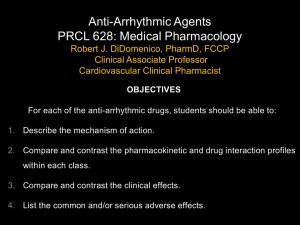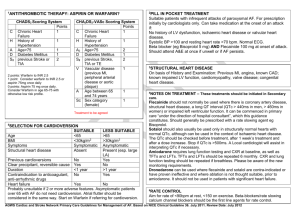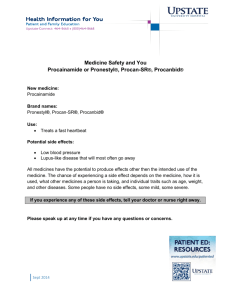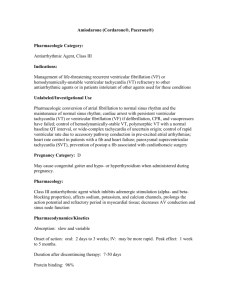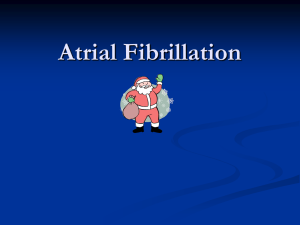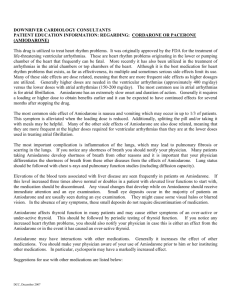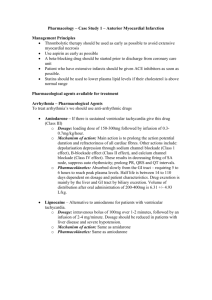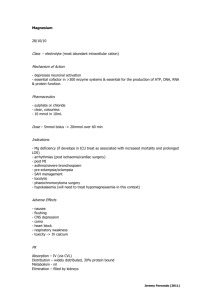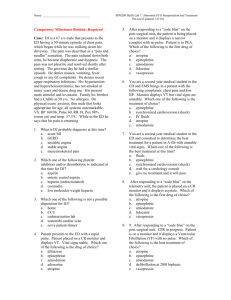Antiarrhythmic Drugs : Present and Future
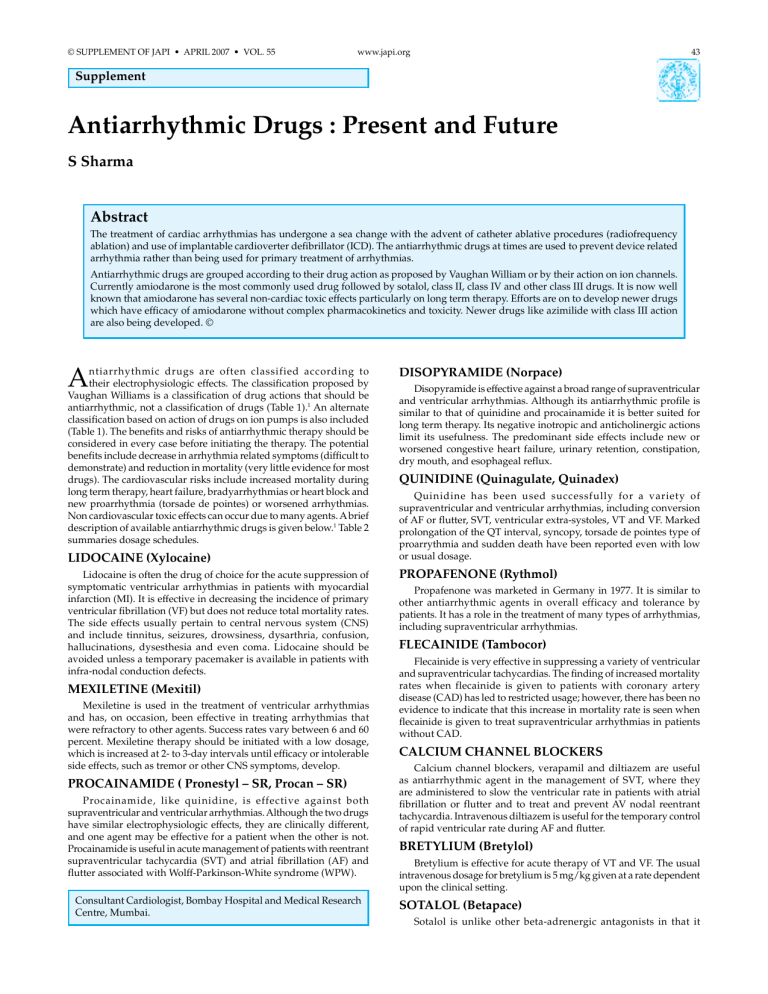
© SUPPLEMENT OF JAPI • APRIL 2007 • VOL. 55
Supplement
www.japi.org
Antiarrhythmic Drugs : Present and Future
S Sharma
43
Abstract
The treatment of cardiac arrhythmias has undergone a sea change with the advent of catheter ablative procedures (radiofrequency ablation) and use of implantable cardioverter defibrillator (ICD). The antiarrhythmic drugs at times are used to prevent device related arrhythmia rather than being used for primary treatment of arrhythmias.
Antiarrhythmic drugs are grouped according to their drug action as proposed by Vaughan William or by their action on ion channels.
Currently amiodarone is the most commonly used drug followed by sotalol, class II, class IV and other class III drugs. It is now well known that amiodarone has several non-cardiac toxic effects particularly on long term therapy. Efforts are on to develop newer drugs which have efficacy of amiodarone without complex pharmacokinetics and toxicity. Newer drugs like azimilide with class III action are also being developed. ©
A ntiarrhythmic drugs are often classified according to their electrophysiologic effects. The classification proposed by
Vaughan Williams is a classification of drug actions that should be antiarrhythmic, not a classification of drugs (Table 1).
1 An alternate classification based on action of drugs on ion pumps is also included
(Table 1). The benefits and risks of antiarrhythmic therapy should be considered in every case before initiating the therapy. The potential benefits include decrease in arrhythmia related symptoms (difficult to demonstrate) and reduction in mortality (very little evidence for most drugs). The cardiovascular risks include increased mortality during long term therapy, heart failure, bradyarrhythmias or heart block and new proarrhythmia (torsade de pointes) or worsened arrhythmias.
Non cardiovascular toxic effects can occur due to many agents. A brief description of available antiarrhythmic drugs is given below.
summaries dosage schedules.
1 Table 2
LIDOCAINE (Xylocaine)
Lidocaine is often the drug of choice for the acute suppression of symptomatic ventricular arrhythmias in patients with myocardial infarction (MI). It is effective in decreasing the incidence of primary ventricular fibrillation (VF) but does not reduce total mortality rates.
The side effects usually pertain to central nervous system (CNS) and include tinnitus, seizures, drowsiness, dysarthria, confusion, hallucinations, dysesthesia and even coma. Lidocaine should be avoided unless a temporary pacemaker is available in patients with infra-nodal conduction defects.
MEXILETINE (Mexitil)
Mexiletine is used in the treatment of ventricular arrhythmias and has, on occasion, been effective in treating arrhythmias that were refractory to other agents. Success rates vary between 6 and 60 percent. Mexiletine therapy should be initiated with a low dosage, which is increased at 2- to 3-day intervals until efficacy or intolerable side effects, such as tremor or other CNS symptoms, develop.
PROCAINAMIDE ( Pronestyl – SR, Procan – SR)
Procainamide, like quinidine, is effective against both supraventricular and ventricular arrhythmias. Although the two drugs have similar electrophysiologic effects, they are clinically different, and one agent may be effective for a patient when the other is not.
Procainamide is useful in acute management of patients with reentrant supraventricular tachycardia (SVT) and atrial fibrillation (AF) and flutter associated with Wolff-Parkinson-White syndrome (WPW).
Consultant Cardiologist, Bombay Hospital and Medical Research
Centre, Mumbai.
DISOPYRAMIDE (Norpace)
Disopyramide is effective against a broad range of supraventricular and ventricular arrhythmias. Although its antiarrhythmic profile is similar to that of quinidine and procainamide it is better suited for long term therapy. Its negative inotropic and anticholinergic actions limit its usefulness. The predominant side effects include new or worsened congestive heart failure, urinary retention, constipation, dry mouth, and esophageal reflux.
QUINIDINE (Quinagulate, Quinadex)
Quinidine has been used successfully for a variety of supraventricular and ventricular arrhythmias, including conversion of AF or flutter, SVT, ventricular extra-systoles, VT and VF. Marked prolongation of the QT interval, syncopy, torsade de pointes type of proarrythmia and sudden death have been reported even with low or usual dosage.
PROPAFENONE (Rythmol)
Propafenone was marketed in Germany in 1977. It is similar to other antiarrhythmic agents in overall efficacy and tolerance by patients. It has a role in the treatment of many types of arrhythmias, including supraventricular arrhythmias.
FLECAINIDE (Tambocor)
Flecainide is very effective in suppressing a variety of ventricular and supraventricular tachycardias. The finding of increased mortality rates when flecainide is given to patients with coronary artery disease (CAD) has led to restricted usage; however, there has been no evidence to indicate that this increase in mortality rate is seen when flecainide is given to treat supraventricular arrhythmias in patients without CAD.
CALCIUM CHANNEL BLOCKERS
Calcium channel blockers, verapamil and diltiazem are useful as antiarrhythmic agent in the management of SVT, where they are administered to slow the ventricular rate in patients with atrial fibrillation or flutter and to treat and prevent AV nodal reentrant tachycardia. Intravenous diltiazem is useful for the temporary control of rapid ventricular rate during AF and flutter.
BRETYLIUM (Bretylol)
Bretylium is effective for acute therapy of VT and VF. The usual intravenous dosage for bretylium is 5 mg/kg given at a rate dependent upon the clinical setting.
SOTALOL (Betapace)
Sotalol is unlike other beta-adrenergic antagonists in that it
44 www.japi.org © SUPPLEMENT OF JAPI • APRIL 2007 • VOL. 55
Table 1 : Classification of drug actions as proposed by vaughan williams
Class I : Membrane active drugs
IA : Quinidine, Procainamide, Disopyramide,
Moricizine
IB : Lidocaine, Mexiletine, Tocainide, Phenytoin
IC : Flecainide and propafenone
Class II : Beta adrenergic antagonism
Propranolol, Esmolol, Acebutolol, Timolol and
Metoprolol
Class III : Prolong duration of action potential and refractoriness
Amiodarone, Sotalol, Bretylium, Ibutilide, dofetilide, N – acetyl procainamide (NAPA).
Class IV : Calcium channel antagonists
Verapamil and Diltiazem
Unclassified in this system
Digoxin, Adenosine
ALTERNATE CLASSIFICATION OF ANTIARRHYTHMIC DRUG ACTIONS :
Class I — Sodium channel blockers
Disopyramide (Norpace)
Flecainide (Tambocor)
Lidocaine (Xylocaine)
Mexiletine (Mexitel)
Moricizine (Ethmozine)
Procainamide (Procan,
Procanabid, Pronestyl)
Propafenone (Rythmol)
Quinidine (Various)
Tocainide (Tonocard)
Miscellaneous
Adenosine (Adenocard)
Digoxin (Lanoxin)
Class II — Beta blockers
Acebutolol (Sectral)
Atenolol (Tenormin)
Betaxolol (Kerlone)
Bisoprolol (Zebeta)
Carvedilol (Coreg)
Esmolol
Metoprolol (Toprol,
Lopressor)
Nadolol (Corgard)
Propranolol (Inderal)
Sotalol (Betapace)
Timolol (Blocadren)
Class III — Potassium channel blockers
Amiodarone (Cordarone, Pacerone)
Azimilide (Stedicor)
Bepridil
Dofetilide (Tikosyn)
Ibutalide (Corvert)
Sotalol (Betapace)
Tedisamil
Class IV - Calcium channel blockers
Diltiazem (Cardizem, Tiazac)
Verapamil (Calan,
Covera, Isoptin)
Table 2 : Dosage and plasma concentration ranges for antiarrhythmic agents
Agent Usual initial dosage
Modification of dosage in disease
Dosage range
Quinidine (sulfate)
Procainamide
(sustained release)
Disopyramide
Lidocaine
Tocainide
Mexiletine
Flecainide
Propafenone
Amiodarone
(load)
Bretylium
Ibutilide
Dofetilide
200 mg q 6 h
500 mg q 6 h
100 mg q 6 h
—
400 mg q 8 h
200 mg q 8 h
50-100 mg q 12 h
150 mg q 8 h
600-1400 mg/ day
—
1 mg, repeat after 10 min
500 mcg bid
None
↓ CHF
↓ RI
↓ CHF
↓
HI
↓ CHF
↓ CHF
↓ HI
↓ HI
↓ RI
↓ CHF
↓ HI?
↓ CHF
↓ RI
↓ HI ?
SEE TEXT
NONE
↓
↓
RI
—
RI
800-2400 mg / day
2000-6000 mg / day
300-1200 mg / day
1-4 mg/ min IV
1200-2400 mg/ day
600 – 1200 mg/ day
200- 400 mg / day
300 – 900 mg/ day
200 – 600 mg / day
1-4 mg / min IV
0.01 mg / kg – 1 mg X 2
125 – 1000 mcg / d
CHF = Congestive cardiac failure; HI = Hepatic insufficiency; RI = Renal insufficiency
Maximum
Single Dose
600
1500
300
—
800
400
200
300
600
—
1 mg
500 mcg
Therapeutic
Range, µg/mL
0.7 – 5.5
4 – 8
2 – 5
1.5 – 5
4 – 10
0.7 – 2
© SUPPLEMENT OF JAPI • APRIL 2007 • VOL. 55 prolongs the action potential, producing a dose-related increase in refractoriness of cardiac tissues. This unique combination of properties makes sotalol effective in a variety of supraventricular and ventricular arrhythmias. It has been found to be effective in patients with sustained VT evaluated by programmed ventricular stimulation.
A major concern is occurrence of torsades de pointes.
AMIODARONE (Cordarone)
At present, amiodarone is widely used in a wide range of VT,
SVT, for conversion and slowing of rate in AF, AV nodal reentrant tachycardia, and tachycardias associated with the WPW syndrome.
Without a loading-dose regimen, amiodarone requires several weeks to months before producing its antiarrhythmic action. Large intravenous dosages or oral loading dosages can hasten the onset of therapeutic effects. From small prospective studies, loading dosages have varied from 600 to 1400 mg / day for 2 to 21 days. Recent large clinical trials have utilized a lower loading dose, of 600 to 800 mg daily for 14 days. Because of relatively rapid redistribution out of myocardial tissue, the dosage should be tapered over a period of several weeks.
The usual maintenance dose varies from 200 to 600 mg / day, and because of the severe nature of adverse reactions, the lowest effective dosage should be prescribed.
There are several side effects which can occur. The most serious being lethal interstitial pneumonitis. Hyper –or hypothyroidism occurs in 4 percent of patients treated chronically. Accumulation of corneal microdeposits is almost uniform during long-term therapy and can progress to the point of interfering with vision. A proper monitoring of lung function, thyroid function and eye examination is strongly recommended in patients who are on chronic therapy.
IBUTILIDE (Corvert)
Ibutilide was given FDA approval for the rapid conversion of recent – onset AF or flutter in 1995. Ibutilide is available only for intravenous administration.
DOFETILIDE (Tikosyn)
Dofetilide was approved and marketed in 2000 for oral therapy of AF and flutter. In controlled trials of 1000 patients, 30% of patients with AF given a dosage of 500 µg bid converted to sinus rhythm, compared to 6% in the control treated with sotalol and 1% of given placebo. Prevention of recurrence was demonstrated, with 62 to
71 % remaining in sinus rhythm after 6 months, compared to 59% for sotalol and 26 to 37% for placebo. The Danish Investigators of
Arrhythmia and Mortality on Dofetilide, or DIAMOND trial patients with reduced ejection fraction and symptoms of heart failure showed the drug to be safe with reduced incidence of hospitalization for heart failure.
1 in 1518 www.japi.org 45
ADENOSINE (Adenocard)
Adenosine is very effective for the acute conversion of paroxysmal
SVT due to reentry involving the AV node. Sixty percent of patients respond at a dose of 6 mg, and an additional 32 percent respond when given a higher dose, of 12 mg. Because of the fleeting and relatively selective action of adenosine on the AV node, some have suggested that it be used us as a diagnostic tool in patients with narrow and wide – complex tachycardia.
M
ANAGEMENT
O
F
A
RRHYTHMIAS
Atrial fibrillation (AF)
Treating AF, first of all, requires identifying drugs, such as procainamide and disopyramide, and other class IA class IC drugs (flecainide and propafenone)
(amiodarone and sotalol) have all been used.
and, when possible, correcting underlying cardiac or noncardiac arrhythmia persists, attempts should be made pharmacologic or electrical means. Quinidine disorders. If the to terminate it by such as the age of the patient, the duration atrial size, and the severity of and more recently and class III drugs
Depending on factors of the arrhythmia, the left any underlying cardiac or noncardiac disorders, antiarrhythmic-drug to sinus therapy is successful in converting AF rhythm in 35 to 75 percent of patients. Recently, Ibutilide and
Dofetilide have also been utilized for conversion of AF and control of ventricular rate in AF. It is not clear which because different antiarrhythmic drugs in the same patient.
drug is most effective, have rarely been compared
Supraventricular Tachycardia (SVT)
Catheter ablative techniques have revolutionalized the management of patients with SVT. These techniques are treatment of choice for all symptomatic patients with tachycardias mediated by accessory pathways or with atrial flutter and for most patients with symptomatic
AV nodal reentrant tachycardia. In those patients where ablation techniques can not be applied due to financial or other reasons, the long term drug treatment remains important and is summarized in
Table 3.
2
Prevention of Ventricular Tachycardia (VT)
In the past decade ICDs have become firmly established as the first line therapy for survivors of unstable ventricular arrhythmias.
3 The
ICDs are also being increasingly used for primary prevention in high risk patients. The evidence for using ICDs for secondary prevention of
VT comes from three large studies called as AVID, CIDS and CASH.
These studies showed a 20-30 % reduction in all cause mortality with
ICD implantation.
4
Table 3 : Long-term antiarrhythmic-drug therapy for supraventricular tachycardia
Tachycardia
AV nodal reentrant and AV reentrant (concealed by pass tract)
WPW syndrome
Sinus-node reentrant
Unifocal atrial Reentrant
Automatic
Multifocal atrial
First Choice
Calcium-channel blockers, beta-blockers, digoxin
Flecainide, propafenone*
Quinidine, procainamide, disopyramide‡
Calcium-channel blockers, beta-blockers, digoxin
Flecainide, propafenone*
Quinidine, procainamide, disopyramide‡
Beta-blockers, calcium channel blockers, digoxin
Magnesium and potassium supplements
Second Choice
Flecainide, propafenone*†,
Quinidine, procainamide, disopyramide†‡
Beta-blockers, calcium- channel blockers†
Flecainide, propafenone*†,
Quinidine, procainamide, disopyramide†‡
Amiodarone, sotalol
Flecainide, moricizine†
Metoprolol, verapamil†
Third Choice
Amiodarone
Amiodarone, Sotalol
—
—
Amiodarone
—
*For patients with no associated heart disease; †To be used in combination with a first-choice drug; ‡For patients with associated heart disease;
AV = Atrioventricular, WPW = Wolff-Parkinson-White
46
Despite their inferiority with respect to total mortality when compared with ICDs, antiarrhythmic drugs are moderately effective at suppressing both inducible and spontaneous VT.
4 Oral amiodarone appears to be the most effective drug, 50-60 % efficacy in preventing
VT recurrences. Class III drugs also have some efficacy in suppressing
VT. In a recent randomized study, both oral d, I-sotalol (160 mg bid) and dofetilide (5000 mg bid) suppressed the inducibility of VT in about
35% of patients. Either of these drugs is a reasonable option in patients where amiodarone is to be avoided. Class IA drugs have largely fallen out of favor because of side effects, the risk of pro-arrhythmia, and the availability of better options. Nonetheless, procainamide and quinidine are associated with a roughly 30% success in suppressing inducible VT and may play a role in preventing device therapies in selected patients. Finally, lidocaine and mexiletine can be safely used in combination with other medications (e.g. class III drugs or amiodarone) for suppression of VT in difficult cases. www.japi.org © SUPPLEMENT OF JAPI • APRIL 2007 • VOL. 55 in patients with symptomatic tachyarrhythmias and ICDs therapies.
Other drugs, such as ambasilide, are also in clinical development, and chromanol 293B is in preclinical testing.
R
EFERENCES
1. Woosely RL. Antiarrhythmic drugs. Hurst’s The Heart (Ed.
Fuster V, Alexander RW, O’Rourke RA, et al .) 10
2001;1:899–924.
th edition.
2. Ganz GI, Friedman PL. Supraventricular tachycardia. New
England J Medicine 1995;332:162-73.
3. Yadav AV, Das MK, Zipes DP. Selection of patients for ICDs : where are we in 2005? ACC Current Journal Review 2005;14:33–
37.
4. Reynolds RM, Josephson ME. Sustained ventricular tachycardia in ischemic cardiomyopathy : current management. ACC Current
Journal Review 2005;14:63-71.
I
NVESTIGATIONAL
D
RUGS
Analogs of amiodarone, such as ATI-2001, dronedarone, and SR-
33589 are being developed. Dronedarone has a very well characterized pharmacokinetic and pharmacodynamic profile and has a reasonable safety profile at doses lower than 2000 mg per day. More data is needed from this new drug.
Azimilide is an antiarrhythmic drug with potassium-channelblocking properties that prolongs the cardiac action potential and refractory periods. In a recent study azimilide was found to be effective
